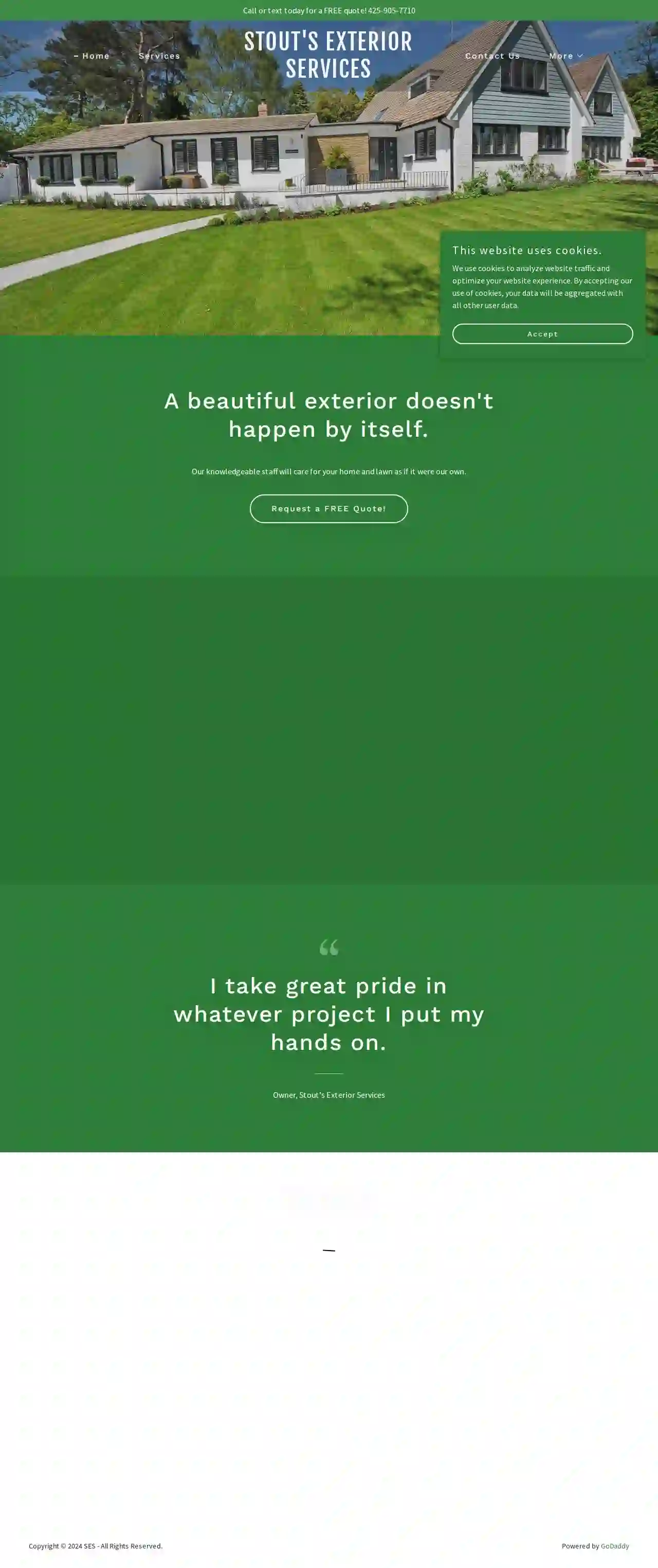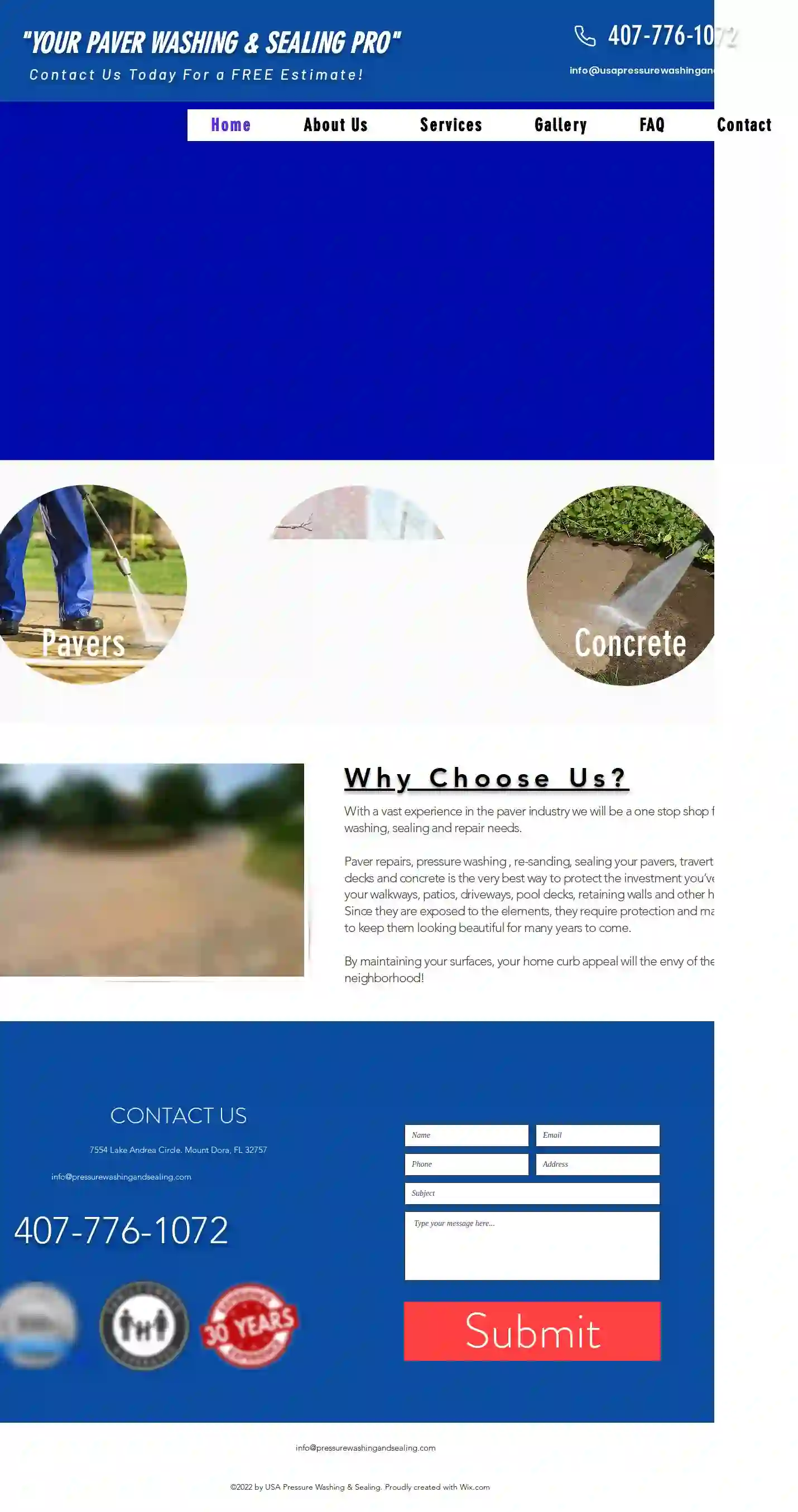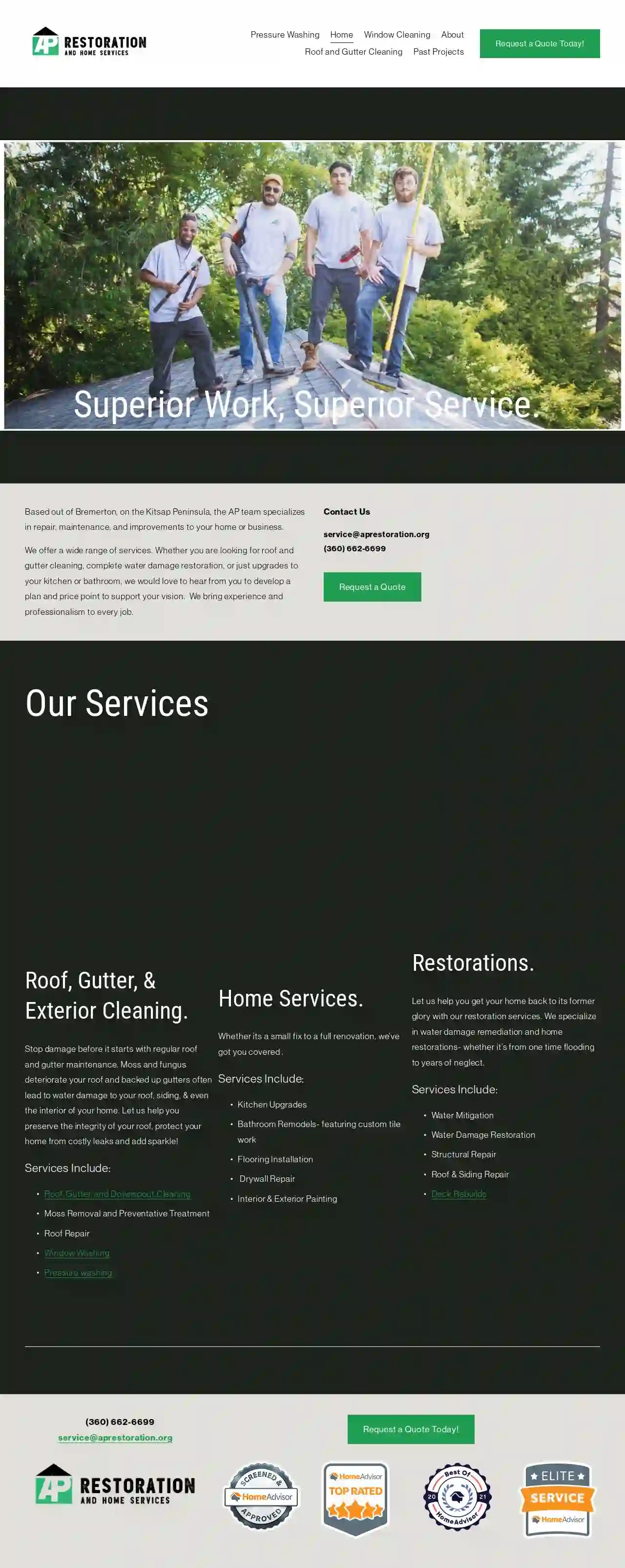Pressure Washing Orting
Find the best Pressure Washing in Orting
Get up to 3 Pressure Washing quotes for your project today! Compare profiles, reviews, accreditations, portfolio, etc... and choose the best offer.

Grace Pressure Washing
561 reviews3317 E Bridgeport Ave, Spokane, WA, 99217, USGrace Pressure Washing is Spokane's most trusted pressure washing company, dedicated to restoring the beauty of your home or business. We're a Christian, family-run business owned and operated by Lydia Grace Hilby and Mark Hilby, who believe that cleanliness is next to godliness. Our team of professional surface cleaners uses the industry's most trusted technology and advanced cleaning techniques to deliver jaw-dropping results at a price anyone can afford. We take pride in serving our community and helping our neighbors enjoy a more beautiful, healthier home. We understand that the appearance of your property can significantly impact your overall happiness and quality of life. That's why we offer a wide range of pressure washing services, including driveway washing, fence washing, house washing, patio cleaning, rust removal, sidewalk cleaning, window washing, deck washing, and solar panel cleaning. When you choose Grace Pressure Washing, you can expect first-class treatment for your surfaces. We're licensed and bonded, and we strive to exceed your expectations with our thorough, uniform cleaning and exceptional customer service. Contact us today to schedule a free quote and let us help you transform your property!
- Services
- Why Us?
- Accreditations
- Our Team
- Testimonials
- Gallery
Get Quote
SuperSonic SoftWash LLC
530 reviews154 131st St E, Tacoma, 98445, USSuperSonic SoftWash LLC is a Bellevue, Washington-based pressure washing company dedicated to helping you maintain your most valuable asset: your home or commercial property. We understand the importance of protecting your investment and strive to provide exceptional pressure washing services that exceed your expectations. Our team of experienced professionals utilizes top-of-the-line equipment to deliver a thorough and meticulous clean, tailored to your specific needs. We offer a wide range of services, including commercial pressure washing, deck washing, driveway washing, graffiti removal, gutter cleaning, house washing, roof cleaning, sidewalk cleaning, and solar panel cleaning. We are committed to providing prompt and thorough communication, ensuring that your unique requirements are met with precision and care. Our 100% satisfaction guarantee reflects our confidence in delivering outstanding results. Choose SuperSonic SoftWash LLC for all your pressure washing needs in Bellevue and surrounding areas.
- Services
- Why Us?
- Accreditations
- Our Team
- Testimonials
- Gallery
Get Quote
Garrett's Pressure Washing
5147 reviews1017 Baxter Ave, Louisville, KY, 40204, USYour Pressure Washing Partner in Louisville Metro, Surrounding Counties, and Southern Indiana. Pressure Washing in Louisville, KY. Book Now 502 767 3236. Louisville's Premier Pressure Washing Experts. If you need exceptional pressure washing in or around Louisville, KY, you’ve found it. Whether it’s deck and patio cleaning, driveway and sidewalk pressure washing, commercial pressure washing, or general exterior cleaning, you can count on our skilled and experienced team at Garrett’s Pressure Washing to make your property’s surfaces look brand-new again. Our services do not end there, you can rely on us to protect your investment further from future damage by sealing your brick home, stone or concrete surfaces, and staining your decks and fences. Louisville is a wonderful place to live, but its ever-changing weather can take a toll on your home’s exterior surfaces. Over time, this collection of dirt, and debris can make your property look dull and worn. Rather than settling for a less-than-ideal exterior, let our team bring new life to your deck, driveway, and other surfaces with a comprehensive pressure-washing service. Pressure washing is much more than spraying down your home with water. It’s a meticulous, detailed process that removes stubborn stains and revives multiple types of exterior surfaces. This is why we also employ a method called “soft washing” to ensure that we do not damage your property. The beauty of leaving all of this to seasoned professionals is that you won’t need to worry about any accidental damage to your property. Our state-of-the-art equipment, cleaning solutions, and fully trained staff also guarantee you 100% satisfaction every time! Give us a Call! We have several locations based in Louisville or Shelbyville, KY. Our crew would love to discuss your exterior cleaning needs and schedule your next service! Book Now 502 767 3236. Our Main Services One of the unique benefits of our pressure-washing services is their impressive versatility. They can do more than renew your concrete walkways. Whether you want to clean organic growth off your house or make your driveway look new again, pressure washing is the solution! As highly experienced professionals, we offer a wide range of services that address nearly every part of your property’s exterior.
- Services
- Why Us?
- Gallery
Get Quote
Stout's Exterior Services
Marysville, USA beautiful exterior doesn't happen by itself. Our knowledgeable staff will care for your home and lawn as if it were our own. Request a FREE Quote! I take great pride in whatever project I put my hands on. Owner, Stout's Exterior Services Reviews
- Services
- Why Us?
- Our Team
- Gallery
Get Quote
USA Pressure Washing & Sealing, LLC
52 reviews7554 Lake Andrea Circle., Mount Dora, 32757, USYOUR PAVER WASHING & SEALING PRO With a vast experience in the paver industry we will be a one stop shop for all your washing, sealing and repair needs. Paver repairs, pressure washing , re-sanding, sealing your pavers, travertine, acrylic decks and concrete is the very best way to protect the investment you’ve made in your walkways, patios, driveways, pool decks, retaining walls and other hardscapes. Since they are exposed to the elements, they require protection and maintenance to keep them looking beautiful for many years to come. By maintaining your surfaces, your home curb appeal will the envy of the neighborhood!
- Services
- Why Us?
- Gallery
Get Quote
AP Restoration and Home Services
53 reviewsBremerton, USSuperior Work, Superior Service. Based out of Bremerton, on the Kitsap Peninsula, the AP team specializes in repair, maintenance, and improvements to your home or business. We offer a wide range of services. Whether you are looking for roof and gutter cleaning, complete water damage restoration, or just upgrades to your kitchen or bathroom, we would love to hear from you to develop a plan and price point to support your vision. We bring experience and professionalism to every job. Contact Us [email protected] (360) 662-6699 Request a Quote Our Services Roof, Gutter, & Exterior Cleaning. Stop damage before it starts with regular roof and gutter maintenance. Moss and fungus deteriorate your roof and backed up gutters often lead to water damage to your roof, siding, & even the interior of your home. Let us help you preserve the integrity of your roof, protect your home from costly leaks and add sparkle! Services Include: Roof, Gutter, and Downspout Cleaning Moss Removal and Preventative Treatment Roof Repair Window Washing Pressure washing Home Services. Whether its a small fix to a full renovation, we’ve got you covered . Services Include: Kitchen Upgrades Bathroom Remodels- featuring custom tile work Flooring Installation Drywall Repair Interior & Exterior Painting Restorations. Let us help you get your home back to its former glory with our restoration services. We specialize in water damage remediation and home restorations- whether it’s from one time flooding to years of neglect. Services Include: Water Mitigation Water Damage Restoration Structural Repair Roof & Siding Repair Deck Rebuilds
- Services
- Why Us?
- Gallery
Get Quote
Quality Pressure Wash
519 reviewsVancouver, USLeave the dirty work to us! Do you want your property to appear its best? Whether your roof is growing bacteria or the pavers in your driveway are dull & dirty, our professional cleaning team will remove dirt, debris, and other particles. We will boost your property's value and curb appeal, while restoring it to its former glory. Your home is your greatest asset and a sanctuary for you and your family. While maintaining the exterior areas around your home can be difficult and time-consuming, Quality Pressure Wash offers a variety of residential cleaning services that will optimize the safety, cleanliness and appearance of your home. QPW's exclusive cleaning service covers anything from big to small, new to old, mostly clean to totally filthy. We've got your back with the best cleaning service in and around Delta, Surrey, Langley and New Westminster...
- Services
- Why Us?
- Testimonials
- Gallery
Get Quote
Mountain View Pressure Washing And Softwash
518 reviews10000 NE 139th St, Vancouver, WA, 98661, USMountain View Pressure Washing and Softwash provides residential and commercial soft washing throughout Vancouver, WA and the surrounding areas. We’re dedicated to providing you with 100% satisfaction. Our processes will safely clean exteriors, roofs, decks, patios, driveways, sidewalks, windows, gutters, and more!
- Services
- Why Us?
- Our Team
- Testimonials
- Gallery
Get Quote
Kentucky Clean Pressure Washing
538 reviews1000 Lexington Rd, Georgetown, 40324, USKentucky Clean Pressure Washing is a locally owned pressure washing company serving Georgetown, Lexington, and the surrounding areas. We specialize in all types of exterior cleaning and restoration, including low pressure, high pressure, hot water use, residential & commercial pressure washing. Our team has many years of experience and uses high-end industrial equipment and chemicals to ensure quality results. We offer a variety of services, including pressure washing and sealing for wood, concrete, brick, stone, vinyl siding, gutters, and more. We also provide graffiti removal. We understand the importance of regular maintenance and restoration for your property's value and appearance. Our professionals can help you determine the best course of action for your specific needs.
- Services
- Why Us?
- Our Team
- Testimonials
- Gallery
Get Quote
Grime Busters Pressure Washing
545 reviewsPortland, USGrime Busters is a young, dynamic company that offers top-quality pressure washing services. We serve the Portland area and specialize in residential, commercial, and industrial properties. Contact us for all your pressure washing needs.
- Services
- Why Us?
- Testimonials
- Gallery
Get Quote
Over 60,241+ Janitorial Services on our platform
Our janitorial service providers operate in Orting and surroundings!
CleaningMatch has curated and vetted Top Janitorial Services near Orting. Find the most trustworthy business today.
Frequently Asked Questions About Pressure Washing
- Reputation and Reviews: Check online reviews and ask for referrals to gauge the company's reputation and customer satisfaction.
- Experience and Expertise: Look for a company with a proven track record and experience in pressure washing various surfaces.
- Licensing and Insurance: Ensure the company is licensed and insured to protect you from liability.
- Equipment and Techniques: Inquire about the company's equipment and techniques to ensure they use appropriate pressure levels and cleaning solutions.
- Quotes and Pricing: Obtain detailed quotes that outline all services and costs.
- Professionalism and Communication: Choose a company that is responsive, communicative, and professional.
- Driveways: Removes oil stains, tire marks, dirt, and grime, restoring the appearance of concrete, asphalt, or paver driveways.
- Decks and Patios: Cleans wood, composite, or concrete decks and patios, removing dirt, mildew, and algae, and preparing them for staining or sealing.
- Fences: Revitalizes wood, vinyl, or composite fences, removing dirt, grime, and weathering, and enhancing their appearance.
- Siding: Cleans vinyl, aluminum, brick, or wood siding, removing dirt, mold, mildew, and other contaminants, and restoring its original color.
- Roofs: Removes moss, algae, and other debris from roofs, extending their lifespan and improving their appearance. Soft washing is typically recommended for roof cleaning to prevent damage.
- Walkways and Sidewalks: Cleans concrete or brick walkways and sidewalks, removing dirt, grime, and stains, and improving safety by reducing slipperiness.
- Brick and Stone: Cleans brick and stone surfaces, removing dirt, mildew, and efflorescence, and restoring their natural beauty.
- 0-degree Nozzle: Produces a highly concentrated, powerful jet of water for removing stubborn stains or stripping paint. Use with caution as it can damage surfaces easily.
- 15-degree Nozzle: A versatile nozzle for cleaning concrete, brick, and other hard surfaces. Provides a good balance of pressure and coverage.
- 25-degree Nozzle: A wider spray pattern for cleaning delicate surfaces like siding or fences.
- 40-degree Nozzle: A very wide spray pattern, ideal for rinsing or applying cleaning solutions.
- Soap Nozzle: A low-pressure nozzle designed specifically for applying cleaning solutions.
- Rotary Nozzle: Also known as a turbo nozzle, it produces a rotating, high-impact spray for tackling tough stains and grime.
- Enhanced Curb Appeal: Pressure washing removes dirt, grime, and stains, instantly revitalizing the appearance of your property and boosting curb appeal.
- Improved Health and Safety: Pressure washing removes mold, mildew, algae, and other contaminants that can pose health risks and create slippery surfaces.
- Increased Property Value: A well-maintained exterior, achieved through regular pressure washing, can increase the value of your property.
- Preventative Maintenance: Pressure washing removes dirt and grime that can deteriorate surfaces over time, extending the lifespan of your driveway, deck, fence, and other exterior features.
- Preparation for Painting or Staining: Pressure washing is an essential step before painting or staining, as it provides a clean and receptive surface for the new coating to adhere to.
What should I look for in a pressure washing company?
A reputable pressure washing company will prioritize safety, use appropriate cleaning methods, and provide excellent customer service.
What surfaces can be pressure washed?
It's important to note that different surfaces require different pressure levels and cleaning solutions. Always consult with a professional pressure washing company to determine the appropriate cleaning method for your specific needs.
What are the different types of pressure washer nozzles?
Choose the appropriate nozzle based on the cleaning task and the type of surface being cleaned. Consult the pressure washer manual or a professional pressure washer for guidance.
What are the benefits of pressure washing?
Whether you're looking to improve your property's appearance, protect its value, or enhance health and safety, pressure washing is a valuable investment.
What should I look for in a pressure washing company?
- Reputation and Reviews: Check online reviews and ask for referrals to gauge the company's reputation and customer satisfaction.
- Experience and Expertise: Look for a company with a proven track record and experience in pressure washing various surfaces.
- Licensing and Insurance: Ensure the company is licensed and insured to protect you from liability.
- Equipment and Techniques: Inquire about the company's equipment and techniques to ensure they use appropriate pressure levels and cleaning solutions.
- Quotes and Pricing: Obtain detailed quotes that outline all services and costs.
- Professionalism and Communication: Choose a company that is responsive, communicative, and professional.
A reputable pressure washing company will prioritize safety, use appropriate cleaning methods, and provide excellent customer service.
What surfaces can be pressure washed?
- Driveways: Removes oil stains, tire marks, dirt, and grime, restoring the appearance of concrete, asphalt, or paver driveways.
- Decks and Patios: Cleans wood, composite, or concrete decks and patios, removing dirt, mildew, and algae, and preparing them for staining or sealing.
- Fences: Revitalizes wood, vinyl, or composite fences, removing dirt, grime, and weathering, and enhancing their appearance.
- Siding: Cleans vinyl, aluminum, brick, or wood siding, removing dirt, mold, mildew, and other contaminants, and restoring its original color.
- Roofs: Removes moss, algae, and other debris from roofs, extending their lifespan and improving their appearance. Soft washing is typically recommended for roof cleaning to prevent damage.
- Walkways and Sidewalks: Cleans concrete or brick walkways and sidewalks, removing dirt, grime, and stains, and improving safety by reducing slipperiness.
- Brick and Stone: Cleans brick and stone surfaces, removing dirt, mildew, and efflorescence, and restoring their natural beauty.
It's important to note that different surfaces require different pressure levels and cleaning solutions. Always consult with a professional pressure washing company to determine the appropriate cleaning method for your specific needs.
What are the different types of pressure washer nozzles?
- 0-degree Nozzle: Produces a highly concentrated, powerful jet of water for removing stubborn stains or stripping paint. Use with caution as it can damage surfaces easily.
- 15-degree Nozzle: A versatile nozzle for cleaning concrete, brick, and other hard surfaces. Provides a good balance of pressure and coverage.
- 25-degree Nozzle: A wider spray pattern for cleaning delicate surfaces like siding or fences.
- 40-degree Nozzle: A very wide spray pattern, ideal for rinsing or applying cleaning solutions.
- Soap Nozzle: A low-pressure nozzle designed specifically for applying cleaning solutions.
- Rotary Nozzle: Also known as a turbo nozzle, it produces a rotating, high-impact spray for tackling tough stains and grime.
Choose the appropriate nozzle based on the cleaning task and the type of surface being cleaned. Consult the pressure washer manual or a professional pressure washer for guidance.
What are the benefits of pressure washing?
- Enhanced Curb Appeal: Pressure washing removes dirt, grime, and stains, instantly revitalizing the appearance of your property and boosting curb appeal.
- Improved Health and Safety: Pressure washing removes mold, mildew, algae, and other contaminants that can pose health risks and create slippery surfaces.
- Increased Property Value: A well-maintained exterior, achieved through regular pressure washing, can increase the value of your property.
- Preventative Maintenance: Pressure washing removes dirt and grime that can deteriorate surfaces over time, extending the lifespan of your driveway, deck, fence, and other exterior features.
- Preparation for Painting or Staining: Pressure washing is an essential step before painting or staining, as it provides a clean and receptive surface for the new coating to adhere to.
Whether you're looking to improve your property's appearance, protect its value, or enhance health and safety, pressure washing is a valuable investment.